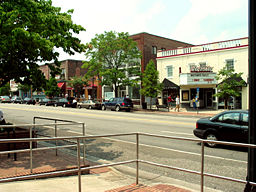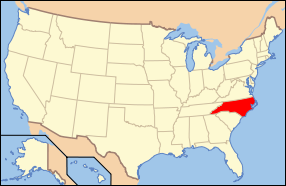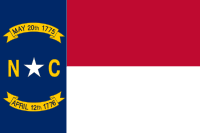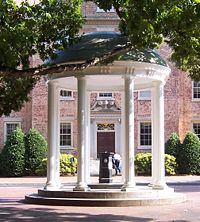Chapel Hill, North Carolina
| Town of Chapel Hill | |||
| Town | |||
 Franklin Street, Chapel Hill
|
|||
|
|||
| Nickname: The Southern Part of Heaven | |||
| Country | United States | ||
|---|---|---|---|
| State | North Carolina | ||
| Counties | Orange, Durham | ||
| Elevation | 486 ft (148 m) | ||
| Coordinates | |||
| Area | 19.8 sq mi (51 km²) | ||
| Population | 54,492 (2007 est.) | ||
| Density | 2,752 /sq mi (1,063 /km²) | ||
| Founded | 1793 | ||
| Mayor | Kevin Foy | ||
| Timezone | EST (UTC-5) | ||
| - summer (DST) | EDT (UTC-4) | ||
| ZIP codes | 27514-27517 | ||
| Area code | 919 | ||
| FIPS code | 37-11800 [1] | ||
| GNIS feature ID | 1019602 [2] | ||
|
Location of Chapel Hill in North Carolina
|
|||
 Location of North Carolina in the United States
|
|||
| Website: Town of Chapel Hill | |||
Chapel Hill is a town in Durham and Orange counties in North Carolina, United States and the home of the University of North Carolina (UNC), the oldest state-supported university in the U.S. The population was 48,715 at the 2000 census; its population was listed at 54,492 in the Census Bureau's 2007 estimates.[3]
Chapel Hill, Durham and Raleigh make up the three corners of the Research Triangle, so named in 1959 with the creation of Research Triangle Park, a research park between Durham and Raleigh.
Contents |
Geography
Chapel Hill is located in the southeast corner of Orange County, with municipal boundaries extending slightly into Durham County to the east and almost to Chatham County to the south. It is bounded on the west by the town of Carrboro and by Chapel Hill Township, which also borders the town to the north and south; on the east Chapel Hill is bounded by the city and county of Durham.
According to the United States Census Bureau, the town has a total area of 19.8 square miles (51.3 km²), of which, 19.8 square miles (51.2 km²) of it is land and 0.1 square miles (0.2 km²) of it (0.35%) is water.
Culture
As is typical of college towns, Chapel Hill and its surrounding area has historically tended to be politically liberal: Orange County voted for Barack Obama 72%-27% over John McCain in the 2008 presidential election[4].
Residents of Chapel Hill have made public education a priority, resulting in Chapel Hill being widely recognized for the quality of its school system, which it shares with Carrboro. Chapel Hill's two older high schools, East Chapel Hill High and Chapel Hill High, are rated as the 105th and 231st best high schools in the U.S. by Newsweek, respectively. A third high school, Carrboro High, opened in 2007.
The town also shares with Carrboro a vibrant music scene. Cat's Cradle in Carrboro is often rated as one of the best clubs in the country for live music, and Local 506 and other Chapel Hill bars (such as the Cave, and Reservoir) often host local, national, and international acts in all genres. The Squirrel Nut Zippers, James Taylor, George Hamilton IV, Southern Culture on the Skids, Superchunk, Polvo and Ben Folds Five are among the notable musical acts whose careers began in Chapel Hill. Chapel Hill has also been a center for the modern revival of old-time music with such bands as the Hollow Rock String band, the Two Dollar Pistols, the Fuzzy Mountain String band, Big Fat Gap and the Red Clay Ramblers.[5] Chapel Hill was also the founding home of now defunct indie label Mammoth Records, as well as now Durham-based Merge Records. Bruce Springsteen has also made a point to visit the town on several tours. His most recent appearance was on September 14, 2003, at Kenan Memorial Stadium with the E Street Band, marking his fourth appearance overall. U2 also performed at Kenan on the first date of their 1983 "War Tour" where Bono famously climbed up to the top of the stage, during pouring rain and lightning, holding up a white flag for peace.
Chapel Hill is rapidly becoming somewhat of a hot spot for pop American cuisine – which is likely due to the college town's entrepreneur-friendly business startup environment, thriving small farms and national media attention surrounding a few local culinary notables, like Foster’s Market (Martha Stewart’s Living), Mama Dip's, Crook's Corner, Caffé Driade (Food Network’s “$40 A Day With Rachael Ray”), The Cackalacky Classic Condiment Company (Food Network's "BBQ With Bobby Flay" and "Rachael Ray's Ball Park Cafe Special," Comedy Central's "Insomniac," OLN's "BBQ All Star Showdown," Associated Press, Public Radio International, etc.), and The Lantern Restaurant (Food & Wine Magazine, Southern Living Magazine, etc.)
Chapel Hill and Carrboro offer many independently owned coffee shops, such as Joe Van Gogh (formerly known as Cup A Joe), Franklin Sweets (formerly Amelia @ Chapel Hill), Open Eye Cafe, 3 Cups, Caffe Driade, and Padgett Station) and bars.
The Chapel Hill/Carrboro Chambers of Commerce supports a vibrant business community among UNC Chapel Hill's strong academic presence. The town hosts a variety of corporations headquartered in Chapel Hill. Health Insurance Provider Blue Cross and Blue Shield of North Carolina (BCBSNC) is one of the town's ten largest employers at its Chapel Hill headquarters. Technology companies USAT Corp., and Realtime Ops have made Chapel Hill their headquarters location. New companies are selecting the town as their base of operations such as the service company Alpha Install.
The Morehead Planetarium was, when it opened in 1949, one of only a handful of planetariums in the nation, and it has remained an important town landmark. During the Mercury, Gemini, and Apollo programs, astronauts were trained there. One of the town’s hallmark features is the giant sundial, located in the rose gardens in front of the planetarium on Franklin Street.
UNC has been very successful at college basketball and women’s soccer (Mia Hamm played as an undergraduate at UNC), and an obsession with the sports has been one of the most distinctive features of the town's culture, fueled by the rivalry among North Carolina's four ACC teams: the North Carolina Tar Heels, the Duke Blue Devils, the NC State Wolfpack, and the Wake Forest Demon Deacons. More recently, the town has received regional notice as the site of a large annual Halloween street party, with an attendance regularly exceeding 70,000.

For more than 30 years Chapel Hill sponsored two annual street fairs, Apple Chill (which was canceled in 2006 due to increasing violence[7]) in April and Festifall in October. The fairs offer booths to artists, craftsmakers, nonprofits, and food vendors. Performance space is also available for musicians, martial artists and other groups. Both fairs are attended annually by tens of thousands.
Like many college towns, Chapel Hill has some unique retail outlets. A Southern Season, a gourmet food and gift store, is based in Chapel Hill, although it also serves a wider audience through its mail-order business.
Chapel Hill also has some new urbanist village communities, such as Meadowmont Village[8] and Southern Village.[9] Meadowmont and Southern Village both have shopping centers, green space where concerts and movies take place, community pools, and schools.
History
Chapel Hill, or at least the town center, indeed sits atop a hill which was originally occupied by a small Anglican "chapel of ease", built in 1752, known as New Hope Chapel. The Carolina Inn now occupies the site of the original chapel. In 1819, the town was founded to serve the University of North Carolina and grew up around it. The town was chartered in 1851, and its main street, Franklin Street, was named in memory of Benjamin Franklin.[10]
In 1968, only a year after its schools became fully integrated, Chapel Hill became the first predominantly white municipality in the country to elect an African American mayor, Howard Lee. Lee served from 1969 until 1975 and, among other things, helped establish Chapel Hill Transit, the town's bus system. Some 30 years later, in 2002, legislation was passed to make the local buses free of fares to residents and visitors alike, leading to a large increase in ridership; the buses are financed through Chapel Hill and Carrboro city taxes as well as UNC student fees.

In the latter part of the 20th century, the town grew considerably and became wealthier, with affordable housing and combating urban sprawl emerging as major local issues. By the late 20th century, higher proportions of the local population worked at jobs unrelated to the university; town surveys indicated that a majority of people working in the town were no longer able to afford in-town housing, and so many people working for the university itself were not able to afford to live in Chapel Hill, or even Carrboro, that charter bus lines were doing a brisk business in almost nothing but bringing in from nearby counties a workforce of secretaries and others on which the university depended.
Government
- See also: List of mayors of Chapel Hill, North Carolina and List of town council members of Chapel Hill, North Carolina
Chapel Hill uses a council-manager form of government. The community elects a mayor and 8 council members. Mayors serve 2-year terms, and council members serve staggered 4-year terms. Current mayor Kevin Foy is a member of the Mayors Against Illegal Guns Coalition,[11] a bi-partisan group with a stated goal of "making the public safer by getting illegal guns off the streets." The Coalition is co-chaired by Boston Mayor Thomas Menino and New York City Mayor Michael Bloomberg.
The town adopted its flag in 1990. According to flag designer Spring Davis, the blue represents the town and the University of North Carolina (whose colors are blue and white); the green represents "environmental awareness"; and the "townscape" in the inverted chevron represents "a sense of home, friends, and community."[12]
The current version of the town's seal, adopted in 1989, is in the process of being replaced with a similar but simpler version. All versions of the seal, dating back to the 1930s, depict Athena, the Greek goddess of wisdom and protector of cities.[13]
Media
- The Daily Tar Heel, published by The University of North Carolina at Chapel Hill, is the main source of print news.
Notable present and former residents
- See also: List of alumni from University of North Carolina at Chapel Hill

- K. A. Applegate, author
- Lewis Black, comedian
- Fred Brooks, computer scientist
- Cam Cameron, football coach
- Spencer Chamberlain, musician
- Floyd Council, blues singer, the "Floyd" in Pink Floyd
- Sarah Dessen, author
- John Edwards
- Sam Ervin, former North Carolina senator, chairman of the Senate Watergate Committee
- Ben Folds, musician
- Paul Green, playwright
- Bunn Hearn, Major League Baseball pitcher
- Jack Hogan, actor, noted for his role as Private William Kirby on Combat! television series, 1962-1967
- Laurel Holloman, actress
- Alexander Julian, fashion designer
- William Carter Love - U.S. Representative from North Carolina
- Howard Lee, politician
- Nick Perumov, author
- David Rees, political satirist, cartoonist Get Your War On
- Dexter Romweber, rockabilly roots-rocker
- Dean Smith, retired basketball coach
- Silda Wall Spitzer, wife of former New York governor Eliot Spitzer
- Chris Stamey, musician
- James Taylor, musician
- Manly Wade Wellman, novelist
- Kent Williams, painter, illustrator and comics artist
Demographics
| Historical populations | |
|---|---|
| Census year |
Population |
| 1950 | 9,177 |
| 1960 | 12,573 |
| 1970 | 26,199 |
| 1980 | 32,421 |
| 1990 | 38,872 |
| 2000 | 48,715 |
| 2003 | 51,485 |
As of the 2000 census,[1] there were 48,715 people, 17,808 households, and 8,138 families residing in the town. The population density was 2,466.0 people per square mile (952.4/km²). There were 18,976 housing units at an average density of 960.6/sq mi (371.0/km²). The racial makeup of the town was 77.95% White, 11.42% Black or African American, 0.42% Native American, 7.18% Asian, 0.02% Pacific Islander, 1.16% from other races, and 1.85% from two or more races. 3.21% of the population were Hispanic or Latino of any race.
Chapel Hill is North Carolina's best educated city, proportionately, with 77.0% of adult residents (25 and older) holding an associate degree or higher, and 73.7% of adults possessing a baccalaureate degree or higher (2000 Census).
There were 17,808 households out of which 22.4% had children under the age of 18 living with them, 36.2% were married couples living together, 7.5% had a female householder with no husband present, and 54.3% were non-families. 31.2% of all households were made up of individuals and 6.6% had someone living alone who was 65 years of age or older. The average household size was 2.22 and the average family size was 2.88.
In the town the population was spread out with 15.1% under the age of 18, 37.1% from 18 to 24, 24.5% from 25 to 44, 15.3% from 45 to 64, and 8.0% who were 65 years of age or older. The median age was 24 years. For every 100 females there were 82.1 males. For every 100 females age 18 and over, there were 78.5 males.
The median income for a household in the town was $39,140, and the median income for a family was $88,200. Males had a median income of $50,258 versus $32,917 for females. The per capita income for the town was $24,133. About 6.4% of families and 21.6% of the population were below the poverty line, including 8.6% of those under age 18 and 5.6% of those age 65 or over.
References
- ↑ 1.0 1.1 "American FactFinder". United States Census Bureau. Retrieved on 2008-01-31.
- ↑ "US Board on Geographic Names". United States Geological Survey (2007-10-25). Retrieved on 2008-01-31.
- ↑ "Subcounty population estimates: North Carolina 2000-2006" (CSV). United States Census Bureau, Population Division (2007-06-28). Retrieved on 2008-05-28.
- ↑ "CNN Election Center 2008".
- ↑ "Red Clay Ramblers".
- ↑ "murals in Chapel Hill by artist Michael J. Brown".
- ↑ "Chapel Hill votes to kill Apple Chill".
- ↑ "Meadowmont Village".
- ↑ "Southern Village".
- ↑ "MEMORANDUM".
- ↑ "Mayors Against Illegal Guns: Coalition Members".
- ↑ "MINUTES OF A MEETING OF THE MAYOR AND COUNCIL OF THE TOWN OF CHAPEL HILL, NORTH CAROLINA, MONDAY, SEPTEMBER 24, 1990 AT 7:30 P.M.".
- ↑ "Resolution to Update Town Seal". Town of Chapel Hill (April 11 2005).
See also
- The Triangle (North Carolina)
- I-85 Corridor
- East Chapel Hill High School
- Chapel Hill High School
- Area code 919
External links
- Town website
- Chapel Hill travel guide from Wikitravel
|
||||||||||||||||||||||||||
|
||||||||||||||||||||
|
|
||||||||||||||||||||
|
|||||||||||||||||||
|
|||||||||||||||||||


